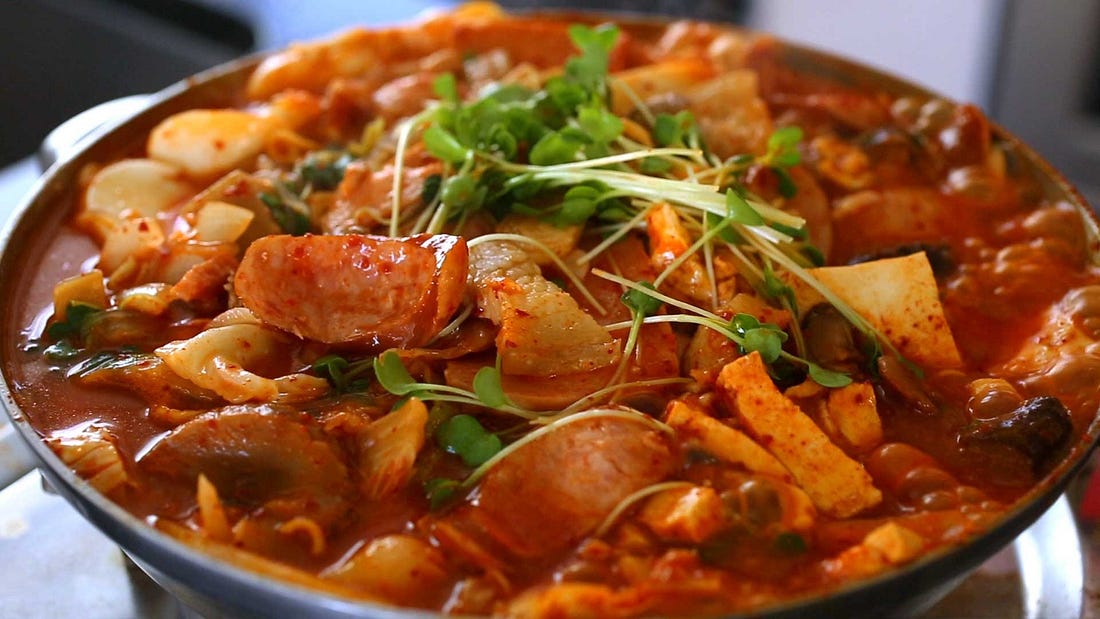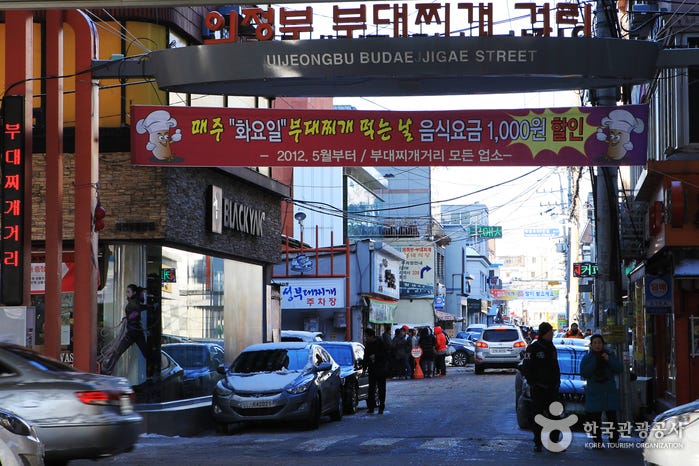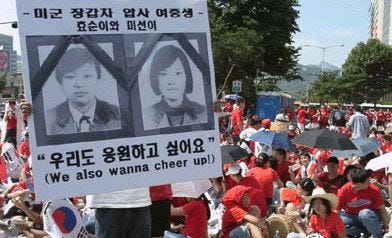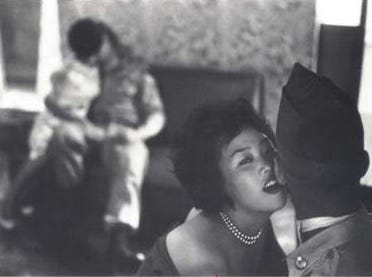Budaejjigae is always served in massive pots. Kept piping hot on a Butane burner, the dish is meant to be shared with a table full of people.
Translated as "military base stew", this dish is largely made up of cheap, processed food. Korean ingredients like Neoguri ramen, kimchi and rice cakes are mixed in with seemingly contrasting American ingredients, such as Spam, hot dogs, and Kraft cheese. It's often eaten by students and young adults in Korea as a form of inexpensive comfort food.
 Source: Maangchi
Source: MaangchiDuring U.S military occupation, "camp towns" started to form around the gates of American army and air force bases. The Koreans that lived and worked in these towns often depended on U.S soldiers for the bulk of their income, whether they were bar owners, tailors, or one of the thousands of Korean women who provided sexual services to U.S soldiers. These towns didn't just develop on their own, either — the South Korean government, backed by the U.S, encouraged the development of camp towns and coerced Korean women to provide sexual labor for American soldiers in order to ensure their stay and improve the economy.
Some people regard budaejjigae as the original Korean-American fusion dish. Others just consider it a bad memory.
Camptowns
I grew up in Songtan, a former Korean camp town surrounding a U.S air force base. Like many other "Amerasian" children, I attended an American elementary, middle, and high school on the base along with other American military brats.
Unlike many of the white and non-Korean families who chose to live in on-base housing, my mom vehemently wanted to live in downtown Songtan. Her argument was that we wouldn't be able to order all the yummy Korean delivery foods, like jjajangmyeon and fried chicken, if we lived on the military base.
It wasn't until later that I realized this was an excuse. There seemed to be an unspoken acknowledgment in my family that my mom simply wouldn't be able to assimilate into typical military spouse communities on base— the book clubs, potlucks, and church gatherings comprised mostly of Christian, American, English-speaking women (usually white, with some exceptions).
This enclave carved out of the Western, patriarchal culture of military life seemed unwelcoming to her. Instead, she removed herself almost entirely from it — and yet she still stayed within proximity, making friends with other Koreans who lived and worked in the camp town, from bar owners to street vendors to other Korean military wives.
Together, they formed their own enclave under the influence of U.S military occupation.
Every morning, my school bus would pick me up in downtown Songtan and take me to the gates of Osan Air Force Base. There, a helmet-clad soldier with a rifle would step on our bus and check all of our military ID cards that marked us as "dependents".
Walking through the front doors of my typical American school, along with a hundred other atypical Amerasian military brats, felt like jumping from the ocean into a fish bowl. We suddenly found ourselves in a bubble, closed off from the rest of the world, but still able to see out into it.
The War
In 1945,after over three decades of brutal colonial suppression, Koreans finally saw independence from the Japanese empire.
Koreans found themselves seized from Japanese colonial rule and almost immediately thrust, once again, into the control of foreign nations. Like children fighting over a room, the United States and Russia each claimed half of Korea's territory. The north, backed by the Soviet Union, would be led by anti-imperialist communist Kim Il-sung. The south, backed by the United States, would be led by staunchly anti-communist, right-wing authoritarian Yi Seung-Man, who had succeeded in winning what many considered to be a rigged election.
The Cold War had begun, and Korea found itself, through no choice of its own, caught in the middle of it.
"The Korean peninsula would serve both as a living laboratory for technologies of domination and as a site of contestation over the United States' fantasy of itself as a nation of saviors."
— Grace M. Cho, Haunting the Korean Diaspora: Shame Secrecy and the Forgotten War
The magnitude of death, trauma, and destabilization that affected the Korean people during and after the Korean War is still immeasurable. Even official statistics don't always account for the massive loss of civilian life.

No Gun-Ri Bridge (with bullet holes ringed in white)
During the war, the U.S-backed authoritarian leader of South Korea, Yi Seung-man, committed massacres against his citizens to suppress communists, leftists, and anyone who opposed U.S military occupation. Meanwhile, the United States launched a brutal aerial bombing campaign against North Korea that killed 20 to 30 percent of the population, an incident that has been compared to attempted genocide. Even in the South, mass killings like the No Gun-Ri Massacre left men, women, and children dead at the hands of U.S soldiers, who were instructed by officers to kill any civilians in the combat zone without discretion.
The war never really ended. In 1953, the Korean Armistice Agreement was signed, ensuring a ceasefire between the two countries and officially establishing the Demilitarized Zone (DMZ) at the 38th parallel.
Military Base Stew
The city of Uijeongbu, near the U.S army base Camp Casey, takes credit for the invention of budaejjigae. I often visited my friends there where the dish is a local staple. Restaurants claiming to have served budaejjigae since the end of the Korean War lines the alleyways.

Source: Korea Tourism Organization
"The stew had long been the stuff of my nightmares. A stew gone wrong. A stew so laden with Spam, hotdogs, American cheese and other "food products" that it had become a perversion of Korean cuisine, indeed, a perversion of real food. Since it represented both the U.S. military occupation of Korea, and my own hidden past, I never thought I could bring myself to eat it."
— Grace M. Cho, Eating Military Base Stew
Food scarcity, especially a shortage of meat, was a severe issue for Koreans during the war. U.S military bases, on the other hand, seemed to be overflowing with food that would end up in the garbage. The solution? U.S military bases began allowing Koreans to purchase bags of the leftover food. Sometimes hungry people would simply scavenge for it in the trash, occasionally finding inedible ingredients like cigarette butts. To this day, Koreans still joke that you can find cigarette butts in a pot of budaejjigae.

2002: Korean protesters demand justice for the victims of the Yangju highway incident.
Coincidentally, the birthplace of budaejjigae is prominent for another reason that's also related to U.S military occupation. In 2002, an armored vehicle operated by U.S military soldiers struck and killed two Korean schoolgirls while returning to base in Uijeongbu. Despite the requests of the South Korean Justice Ministry, the soldiers were tried in U.S military court, where they were found not guilty. The complete acquittal of the soldiers reignited anti-American and anti-U.S military sentiment that had been bubbling in Korea since the war.
The aptly named "military base stew" owes its very existence to the traumatic consequences of war and foreign intervention. The unlivable circumstances caused by the Korean War and prolonged U.S military occupation— massive civilian casualties, loss of infrastructure and industry, widespread famine, rises in sex trafficking and sexual violence— led to circumstances that required Koreans to survive on scraps of food left by their foreign occupiers.
Now, budaejjigae is occasionally touted as a symbol — sometimes of the collision of two dynamically opposed cultures, and other times of the trauma of U.S military occupation and post-war poverty.
The "Yanggongju"
U.S military presence in South Korea continues to this day, with 28,000 to 33,000 troops still stationed on the peninsula. The former "camp towns" are now cities in their own right.

Source: Sex Among Allies by Katharine H.S Moon
The areas surrounding U.S military bases are still heavily peppered with clubs and "G.I bars", many of which serve as a front for brothels. Historically, the women who worked there were derisively referred to as yanggongju.
Yanggongju. Western princess. The literal translation is much kinder than the actual interpretation of the word — the most accurate equivalent would be "yankee whore". Any Korean woman who kept the company of American soldiers could have this word hurled at them, whether they were married to one, lived with one, or served them in bars and brothels.
"She is the woman who simultaneously provokes her compatriot's hatred because of her complicity with Korea' s subordination, and inspires their envy because she is within arm's reach of the American dream."
— Grace M. Cho, Haunting the Korean Diaspora: Shame, Secrecy, and the Forgotten War
It was often the so-called yanggongju who were able to acquire the ingredients needed for budaejjigae. Many of the women would sell American food products that they received from soldiers. At one point, there was a thriving black market in South Korea for American food products. Even one of my Amerasian friends admitted to me that his mother dabbled in the market, selling American beef and Kraft cheese when they were short on money.
Pearl S. Buck, the author of The Good Earth, was the first to coin the term "Amerasian." Eventually, the word became the official term used by the U.S state department to describe the children of American military service-members and Asians (usually women) in the country of their station. I have not yet encountered another term that describes this specific group of people.
Amerasians have widely differing experiences of social stigma, racism, colorism, and political and social disenfranchisement. For one, Amerasians from the Philippines have been repeatedly excluded from legislation that allows overseas Amerasians to immigrate to the United States. Not only that, but there are currently an estimated 30,000 or more "Kopinos" (children born to a Filipino mother and Korean father), the majority of whom are unable to receive assistance despite being legally entitled to child support under Korean law. In an ironically similar circumstance to the American soldiers who left Korean women with Amerasian children, Korean men indulge in relationships with Filipino women and also leave without taking responsibility for their families.
Almost all of my friends from school were Amerasian, with few exceptions. We related to each other on many similar experiences — the food we ate at home, the things we did for fun off-base, the Korean and American holidays we celebrated— while simultaneously leaving so much unspoken.
None of us ever brought up or questioned the history and circumstances that led to our seemingly contradictory lives — American kids with Korean heritage, living on Korean soil, learning American history and culture that didn't even acknowledge our existences or the intergenerational trauma we inherited.
You would have thought that it was merely a coincidence that we all happened to have Korean mothers and American fathers.
Though it occasionally felt isolating, I had a community of sorts. Unlike Amerasians who grew up in Korea with single mothers, or were placed in orphanages, we were able to attend U.S Department of Defense (DOD) schools on military bases.
In other words, we had the immense privilege of assimilating into American culture— if we wanted to.
Amerasians
Since the Korean War,more than 160,000 Korean children have been sent overseas for adoption. A disproportionate number of those children are mixed-race or were born to single mothers. It was all too common for American servicemen to father biracial children with Korean women before leaving the country once their military tour ended.
As a result, these women were left to raise their children as single mothers while facing harsh social stigma. Meanwhile, the South Korean government searched for a way to quietly remove hundreds of thousands of mixed-race children by opening up international adoption. The presence of these children were associated with Korean sex workers, camp towns, and U.S military occupation — as a result, they were considered undesirable. Many Korean mothers gave up their mixed-race children to orphanages for international adoption, believing that their children would have a better life overseas. This was especially true for Afro-Amerasians, who were less likely to pass for Korean and experienced the intersecting effects of antiblackness and cultural stigma against mixed children.
When discussing the stigma that mixed-race children and their mothers experience in Korea, the blame is often placed on Korean culture and society for preaching a narrative of racial purity or for being historically patriarchal. While these are accurate observations, it's important to consider the role of collective, intergenerational trauma reaching back to the Korean War and Japanese colonization (Cho, 2008, p. 6). Just as the term yanggongju is fueled by generations of anger toward the United States for aiding in the loss of Korea's autonomy and independence, so is much of the discomfort, shame, and disgust expressed toward Amerasians.
To many Koreans, Amerasians are a living reminder of the trauma caused by U.S military occupation in Korea. Amerasians exist as living proof of the existence of the yanggongju. In her book, Haunting the Korean Diaspora: Shame, Secrecy, and the Forgotten War, Cho describes the yanggongju as an unspoken, ghostly memory — a specter left over from a traumatic past that reaches back to years of foreign invasion and institutionalized sexual violence affecting Korean women (Cho, 2008, p. 3).
My Mom
"Aigoo-ya, they probably sending money to their family," my mom would say. She was talking about other Korean women married to American servicemen, probably one of the mothers of my many Amerasian friends.
"Mimi-chan (her nickname for me), you know I come from rich family right?" My mom scowled. "I married your daddy because I love him. He come from poor family, you understand?"
I didn't understand why she would tell me this. I already knew my dad was poor. He was the son of a janitor and a truck driver, and grew up in rural Oklahoma. He enlisted in the military right out of high school and was stationed in Korea, where he met my mother in the camp town — likely in a "G.I club".
And I certainly knew my mom had been wealthy — she would never shut up about her grandma's rice fields, even though she never saw a cent of her inheritance because she had the misfortune of being the only daughter in her family.
As a child, it seemed mean-spirited to me. Why ridicule women who are just trying to survive? I thought. Why ridicule my own family because they grew up poor?
Now, I realize that she had been plagued with a complex cocktail of emotions. Resentment, anger, pride, and most of all: fear. Anger at the stigma that she had to face for marrying an American servicemen. Anger at her country's loss of autonomy to the United States and the trauma her parents and grandparents went through. Resentment at the loss of her inheritance and the loss of her family's support. Pride in the face of people who assumed that her family must be relying on my white American father's money when, in fact, it was the other way around.
Fear, the immense fear, that her daughter would grow up to know the word yanggongju. That I would grow up to learn what so many people think of children like me. That I would learn to hate her and hate myself.
Some women in this position keep silent. Perhaps by leaving the past unspoken, it will simply fade, just as the Korean War faded into the Forgotten War.
Other women, like my mom, desperately want to take control of the narrative. She wanted to make sure she was the first to tell me her story, the way she saw fit.
I'm not like them, she seemed to say. I am someone. Which means you're not like them, either.
Recently, I told my mom that I'm making arrangements to study abroad in South Korea for a semester. She's still strongly against the idea of me returning there.
"You better not go to some G.I club," she yelled at me. "I don't want to see you at some place like that! You hear me?"
The fear that I would repeat history. Girls become lovers who turn in to mothers.
So mothers be good to your daughters too.
Mom's 부대찌개 (Military Base Stew)
Jin Ramen
Kimchi
Spam (sliced long and thin)
Ground beef
Hot Dogs (chopped thin diagonally OR cut into octopus shape)
White onion
Green onion
Tofu (sliced into thin rectangles)
Dukguk (thin sliced Korean rice cakes)
Kraft American cheese slices
Gochugaru (Korean chili pepper flakes)
Gochujang (Korean chili pepper paste)
White rice
Optional: Baked beans, Mandu (Korean dumplings), Chicken broth
- In a shallow pot, put the kimchi, ground beef, white onion, ramen noodles (with the contents of the flavor packet and vegetable packet), and about a tablespoon of gochujang at the bottom. Add the chicken broth as well if needed. (OPTIONAL: grill or pan fry the sliced hot dog)
- Pour as much water as needed for the broth (about 2 ⅓ cups for each person being served or for each pack of ramen used).
- Throw the sliced spam, hot dog, green onion, and tofu on top. If you're using mandu, throw only a few on top and make sure it's submerged in the broth. Sprinkle over with gochugaru.
- Budaejjigae is traditionally cooked on a Butane burner or hot pot right on the table in front of your friends and family. If you don't have a hot pot or burner, just cook it on the stove. Bring the water to a boil and then let it simmer once the noodles, dukguk, and mandu are tender and cooked.
- While the stew is still hot, add a couple slices of Kraft American cheese on top, and baked beans if you're using it. Serve with a bowl of white rice on the side.
Source: My mom
More from Baek.Media
FB || Twitter || WordPress|| ThoughtCatalog || Odyssey
If you liked this story, buy me a Ko-Fi!
MSG Debunked: The Science Beneath the Racism
Mistaken Identities: Being the Wrong Asian Girl
Communities come together to protest white supremacists at Hot Springs pro-Confederate rally
- 6 Instant Noodles That Helped My Broke Ass Survive 2016 ›
- Renea Goddard on Odyssey ›
- What It Means To Be 'Amerasian' In Korea ›
- Budae Jjigae Korean Army Stew Recipe · i am a food blog i am a ... ›
- Korean Army Stew (Budae Jjigae) - Beyond Kimchee ›
- Budae Jjigae (Army Stew) - My Korean Kitchen ›
- Army Base Stew - Gastro Obscura ›
- Budae-jjigae - Wikipedia ›
- Army base stew (Budae-jjigae: 부대찌개) - YouTube ›
- Budae-jjigae (Army Base Stew) recipe - Maangchi.com ›
- Eating Military Base Stew - Contexts ›
- Grace M. Cho. Haunting the Korean Diaspora: Shame, Secrecy, and ... ›
- Haunting the Korean Diaspora: Shame, Secrecy, and the Forgotten ... ›
- Gusts Of Popular Feeling: "They branded us as whores, yanggongju ... ›
- Prostitutes in South Korea for the U.S. military - Wikipedia ›
- What Role for U.S. Military in South Korea in a Peninsula at Peace? ›
- [FEATURE] Hard knock lives of Koreans born to U.S. soldiers ›
- Being Amerasian in South Korea: Purebloodness, Multiculturalism ... ›
- The Forsaken: Portraits of Mixed-Race Orphans in Postwar Korea ... ›












